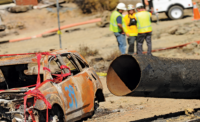Under a newly enacted pipeline safety bill, oil and gas pipeline companies could face additional safety requirements, and pipeline operators that violate federal rules will have to pay stiffer fines.
But the legislation’s impact on safety and industry won’t be clear for many months because its implementation deadlines for key regulations are not until 2013 or 2014. Further, the law gives the U.S. Dept. of Transportation substantial leeway to consider the economic impact of the new rules.
Other provisions call for federal studies of only certain pipeline-safety issues and may not ultimately lead to rules.
Energy industry officials say their current pipeline practices already adhere to many requirements of the new law and say they are considering going beyond them.
The legislation, which President Obama signed into law on Jan. 3, applies to companies that own or operate pipelines that transport oil, natural gas or hazardous liquids.
Industry and government officials praised the measure overall, though they have concerns about some provisions. A major environmental organization sees pluses and minuses in the final version.
DOT Secretary Ray LaHood called the statute “another terrific step for greater pipeline safety.” DOT’s Pipeline and Hazardous Materials Safety Administration (PHMSA) is charged with implementing the law.
“It’s a good bill,” says Cathy Landry, a spokeswoman for the Interstate Natural Gas Association of America (INGAA). “We’re pleased that we have some regulatory certainty,” Landry adds. “It’s nice to know what we have ahead of us, rather than kind of guessing at what could come down the pike.”
Peter Lidiak, American Petroleum Institute pipeline director, says, “We were generally very supportive of the bill. We ended up with an end result that is really pretty acceptable to the folks involved.”
The Sierra Club is taking a neutral stance. Lena Moffitt, a Washington representative for the organization, says the statute “takes some important steps forward, but others backward.” She adds, “We’re happy to see bipartisan legislation make it through this Congress at all.”
One key provision that did take effect immediately after the bill was signed was a sharp increase in federal fines for pipeline-safety infractions.
The new law doubles civil penalties, to $200,000 per day, for each violation. It also doubles to $2 million the maximum fine for “a related series of violations.” In addition, the statute authorizes civil penalties against anyone who “obstructs” federal pipeline inspections or investigations.
As suggested earlier, the impact of the measure’s regulatory provisions won’t be evident for a while. For example, the measure directs PHMSA to issue a regulation within two years mandating automatic or remote-controlled shut-off valves on new pipelines as well as the complete replacement of shut-off valves on old pipelines. But the measure adds a significant condition, stating that the valve requirement should apply “where economically, technically and operationally feasible."
San Bruno Pipeline Explosion
One factor behind the bill in general—and the valve provision in particular—was the September 2010 natural-gas pipeline explosion in San Bruno, Calif. The blast killed eight and destroyed an entire neighborhood.
The pipeline, operated by PG&E, lacked an automatic shut-off valve. Such equipment would have lessened the damage in San Bruno, where the 2010 firestorm raged uninterrupted for 95 minutes.
The National Transportation Safety Board, which probed the San Bruno accident, last September faulted PG&E for a “lax system of oversight, woefully inadequate pipe and inspection programs, poor recordkeeping and an integrity management program without integrity.”
NTSB’s post-investigation recommendations, issued in September 2011, included mandating automatic or remote-controlled shut-off valves, conducting threat assessments and requring pipelines built before 1970 be subjected to hydrostatic pressure tests.
The California Public Utilities Commission (CPUC) has been formulating tough pipeline-safety rules in the wake of San Bruno. The rules may require replacing old, worn-out or damaged gas pipelines and installation of automatic shut-off valves.
With its language directing PHMSA to consider the economic, technical and feasibility factors in drafting its rule regarding shut-off valves, the federal law is weaker than the CPUC’s planned regulations and also falls short of NTSB’s recommendation.



